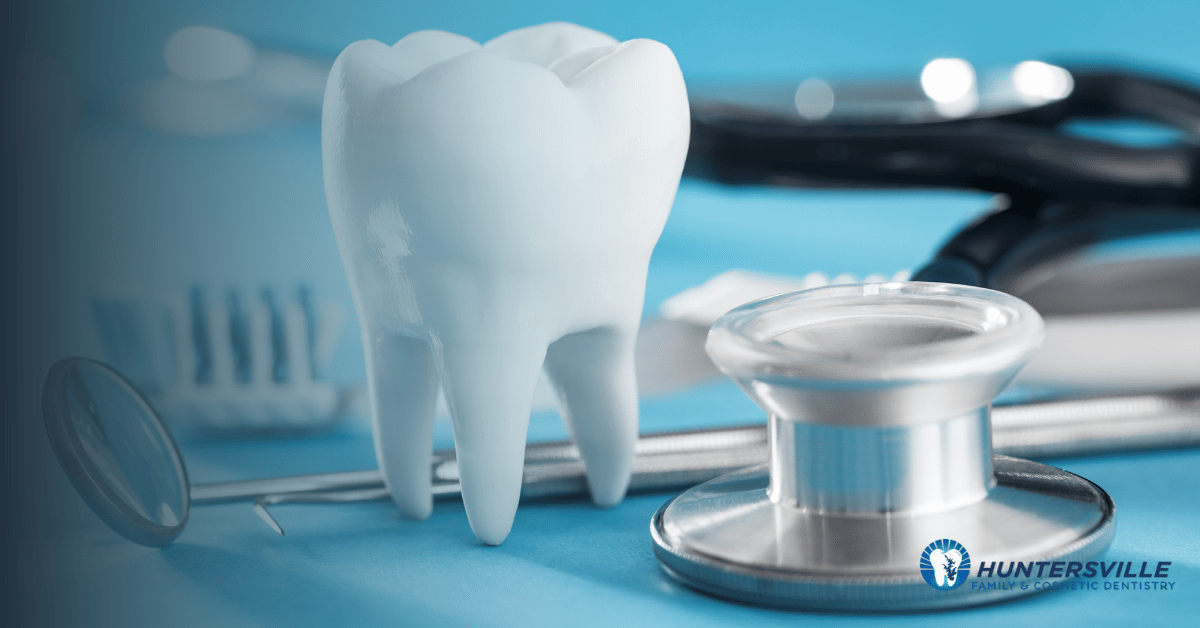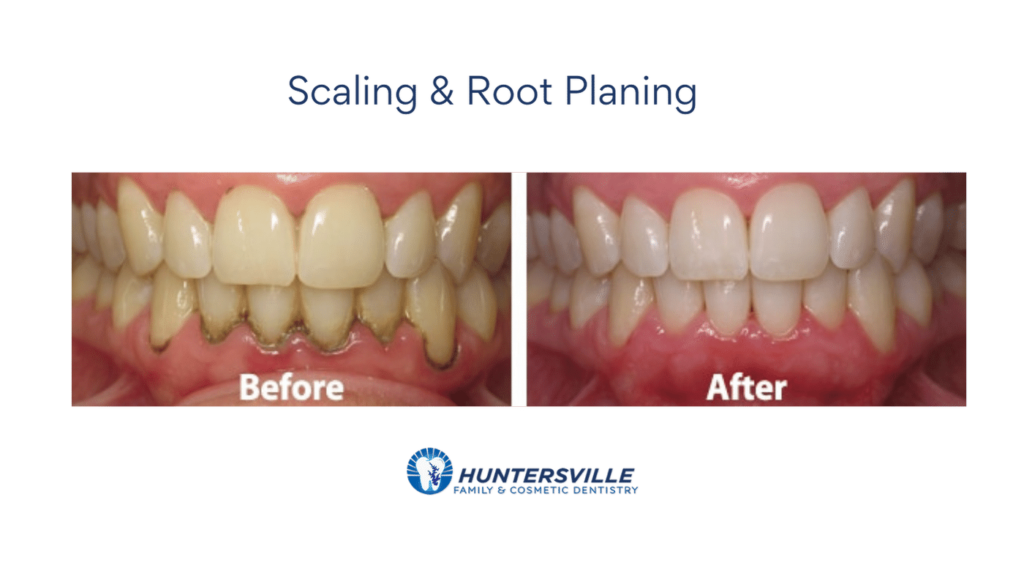
Gum Disease Advice From NIDCR and The CDC
Gum disease, or periodontal disease, is a type of bacterial infection that targets the tissues that surround and support your teeth. This disease usually originates at the gum line, where your gums and teeth meet.
Patients can experience mild inflammation of the gums, known as gingivitis. This can lead to a more severe form of gum disease, called periodontitis. If left untreated, periodontitis may result in tooth loss for affected patients.
Our dental staff in Huntersville intends for this article to provide you with the information you need to make informed decisions about dental treatment and prevention for gum disease. This article will cover various topics, including…
- Causes & Symptoms
- People Most At Risk
- Breakdown Based On Demographics
- How The Condition Is Diagnosed
- Treatment Options For Adults & Children
- Gum Disease Prevention
- Advice From the NIDCR & CDC
- Resources For More Information
Let’s dive in.
The Progression Of Early-Stage Gum Disease
The onset of gum disease begins with the accumulation of plaque. Plaque is a sticky bacterial film that forms on your teeth and gums. If plaque is not removed by regular brushing and flossing, it can harden into tartar, which requires professional teeth cleaning to remove.
If left to accumulate, plaque and tartar bacteria will cause inflammation. They do this by releasing toxins that irritate the gums and trigger an immune response. As the bacteria continue to multiply and spread, the inflammation will progress to periodontitis.
Fortunately, periodontal disease develops slowly. In most cases, it only occurs if there is prolonged neglect of your oral care routine.
Causes
In our practice, we emphasize patient education because inadequate dental hygiene is the main cause of gum disease. Aside from tobacco use, hormones, medications, and genetics, various factors can play a role in the emergence of the disease. Medical issues like diabetes can also be a factor.
Symptoms
We have encountered patients with hardly any signs of gum disease. This is typically associated with a type of disorder called Asymptomatic apical periodontitis.
Apical periodontitis (AAP) is an inflammatory condition. It is characterized by the destruction of the apical periodontium. This destruction is caused by a bacterial infection in the root canal system. Despite being commonly characterized as a radiolucent area at the apex, asymptomatic apical periodontitis (AAP) may still exist. It may progress without noticeable clinical symptoms. As such, regular dental checkups are recommended to detect and address early signs of the condition, otherwise, progression is inevitable.

For the most part, early-stage gum disease is painless. However, mild, and even severe symptoms of progressive gum disease exist and can vary depending on the severity of the condition.
Symptoms typically include:
- Red, swollen, or tender gums
- Bleeding gums, especially when brushing or flossing
- Receding gums
- Persistent bad breath or a bad taste in the mouth
- Loose or shifting teeth
- Changes in the way your teeth fit together when you bite down
You may be able to treat very early-stage gum disease (gingivitis) at home. One way to do this is to use home remedies like oil pulling to kill the bad bacteria. However, Periodontitis, also known as late-stage gum disease, typically requires professional treatment such as deep cleaning, scaling and root planing.
It is strongly recommended by health professionals and the NIDCR that you consult with a dentist. This is if you are experiencing any form of gum disease, whether it is at an early or advanced stage.
Who is at Risk for Gum Disease?
Anyone can develop gum disease, but some people are at higher risk than others. The risk factors for gum disease include
- Poor oral hygiene
- Smoking or using tobacco products
- Age (the risk of gum disease increases as you get older)
- Genetics
- Hormonal changes (such as during pregnancy or menopause)
- Certain medical conditions (such as diabetes)
- Taking certain medications (such as steroids, cancer drugs, or anticonvulsants)
In addition to these risk factors, research has also found a possible link between gum disease and other health conditions. Experts recommend that people with gum disease take extra care to maintain their overall health. They should also work with their healthcare providers to manage any related conditions. By taking steps to prevent and treat gum disease, individuals can help protect their oral and overall health.

Gum Disease Cases Based on Demographics
Gum disease affects millions of people around the world. Yet, certain groups are at a higher risk of developing the condition than others. The CDC found that, compared to other age groups, adults 30 and over, males, smokers, and those living in poverty are more likely to suffer from gum disease.
African Americans and Hispanics are also more likely to develop gum disease than non-Hispanic whites. The CDC’s findings show that these demographics are more likely to develop gum disease for several reasons, including
Genetic Predisposition
Genetic factors may play a role in the development of gum disease, and certain ethnic groups may be more susceptible to these genetic factors. Certain genetic variations can affect the way a person’s immune system responds. This can increase their risk of developing gum disease, as it affects the response to bacterial infections in the mouth.
Socioeconomic Factors
African Americans and Hispanics are more likely to experience poverty and have limited access to dental care. This can result in a lack of preventive care and early treatment for gum disease. This can then contribute to higher rates of the disease in these populations.
Systemic Health Conditions
Certain systemic health conditions, such as diabetes and heart disease, are more common in African Americans and Hispanics and can increase the risk of gum disease.
In the publication, “Disparities In Oral Health” the CDC reported that the prevalence of advanced gum disease is highest among Mexican Americans (47.2%) and African Americans (46.4%) compared to non-Hispanic whites (32.6%).
These statistics highlight the importance of addressing disparities in oral healthcare access and education. Awareness will help reduce the burden of gum disease and other oral health problems in these populations.
It’s important for individuals from all racial and ethnic groups to prioritize good oral hygiene practices. This includes seeing your dentist regularly for checkups and cleanings.
What is the Outlook for People with Periodontal Disease?
The outlook for people with gum disease depends on the severity of the condition and how early it’s diagnosed and treated. In the beginning, gingivitis can be reversed by having good oral hygiene and getting a professional dental cleaning from a dentist.
Diagnosis
Dental services providers at our practice will look for signs of gum disease during your regular dental check-ups. We may use a periodontal probe to measure the depth of the pockets between your teeth and gums. This can indicate the presence of gum disease.
We may also take X-rays to check for bone loss around the teeth.
Treatment
Our recommendation for the treatment of gum disease will depend on the severity of your condition. In its early stages, we may recommend a professional dental cleaning to remove any plaque and tartar buildup. For progressive gum disease, we may recommend a deep cleaning called scaling and root planing. This procedure removes plaque and tartar from the roots of your teeth.
In some cases, surgery may be necessary to repair or replace damaged tissues.

If you have been diagnosed with gum disease, there are several steps you can take. These steps will help improve your outlook and prevent further damage to your teeth and gums. In addition to following your dentist’s recommendations for treatment, it’s important to maintain good oral hygiene practices at home.
Personal responsibility is a big part of prevention and treatment success. Consider making lifestyle changes, such as quitting smoking. Also, manage any underlying health conditions that may be contributing to your gum disease.
Is Treatment Different for Adults vs Children?
Our dentists in Huntersville NC treat both adults and children for gum disease. The treatment for gum disease is generally the same for both. However, children with gum disease may require more frequent dental cleanings. Furthermore, they may need more intensive treatment because their teeth and gums are still developing.
Gum Disease Prevention Tips From the NIDCR and CDC
The National Institute of Dental and Craniofacial Research (NIDCR) is one of the 27 institutes and centers of the National Institutes of Health (NIH) in the United States. The NIDCR is the federal government’s lead agency for scientific research on dental, oral, and craniofacial health and disease.
The Centers for Disease Control and Prevention (CDC) is a national public health institute in the United States. It is a part of the Department of Health and Human Services.
Both organizations are involved in providing the public with information and best practices as it relates to health. This includes oral care. Their advice in regard to gum disease prevention is similar and is summed up below.
The Best Oral Care Routine For Gum Disease Prevention
Preventing gum disease starts with good oral hygiene practices, including:
- Brushing your teeth twice a day with a fluoride toothpaste
- Flossing daily to remove plaque and food particles from between your teeth
- Using an antiseptic mouthwash to kill bacteria that cause gum disease
- Eating a healthy diet rich in fruits, vegetables, and whole grains
- Avoiding tobacco products and limiting alcohol consumption
- Visiting your dentist regularly for check-ups and cleanings
As far as preventing gum disease in children, our family dentist recommends a 3-step plan.
Firstly, you can ensure that your children consume a healthy and balanced diet. This diet should be low in sugar and high in nutrients such as calcium and vitamin C. These nutrients can help to strengthen teeth and gums.
Secondly, you can encourage your children to brush their teeth twice a day with fluoride toothpaste. They should also floss daily to remove plaque and food particles from their teeth and gums.
Lastly, parents can take their children for regular dental check-ups. Cleanings can be done to detect and treat any early signs of gum disease.
By following these 3 steps, parents can help to ensure that their children maintain healthy teeth and gums and reduce their risk of developing gum disease in childhood and later in life.
If you want to learn more about gum disease, the National Institute of Dental and Craniofacial Research (NIDCR) and the Centers for Disease Control and Prevention (CDC) both have extensive resources available on their websites. Here are some articles you may want to check out:
National Institute of Dental and Craniofacial Research (NIDCR):
Gum Disease Advice: Periodontal (Gum) Disease Overview
Periodontal (Gum) Disease: Causes, Symptoms, and Treatments
Centers for Disease Control and Prevention (CDC):
Gum Disease: Fast Facts & Statistics
Periodontal Disease: Gum Disease Warning Signs
These resources provide a wealth of information about gum disease, including causes, symptoms, diagnosis, treatment, and prevention tips.
Best Periodontist Huntersville NC – Gum Specialist
Gum disease is a common condition that can lead to serious dental problems if left untreated. The dental practitioners at our Huntersville NC dentist office would be happy to provide you with a comprehensive examination. This examination will determine if you have gum disease. They will also recommend the best course of treatment to restore your oral health.
Our experienced dental team is located at Huntersville Family & Cosmetic Dentistry. They utilize the latest technology and techniques to provide personalized care. This is done to help prevent gum disease from progressing.
We also educate our patients on proper oral hygiene practices and provide tips for maintaining healthy gums and teeth at home. Don’t wait until it’s too late – schedule your dental checkup today to ensure a healthy smile for years to come.
Search Our Site
Meet Our Family & Cosmetic Dentists in Huntersville, NC
If you are looking for a dentist in Huntersville, NC, you have come to the right place. We are ready to help you get started on the path to improving your family’s oral health. Our combined experience and gentle care provide each member of your family the attention they deserve.
Do You Need An Appointment?
Recent Posts
Common Questions About Dental Services at Huntersville Dentistry
Common Questions About Dental Services at Huntersville Dentistry Choosing the right dental services [...]
Huntersville Dentistry Practice Services We Offer
Huntersville Dentistry Practice Services We Offer Welcome to Huntersville Family & Cosmetic Dentistry, [...]
Why Teeth Cleaning & Dental Sealants Are Great For Kids
Ensuring your child's radiant smile involves more than just brushing at home; it’s [...]
Tooth Fairy Magic: Encouraging Kids’ Dental Hygiene
A Sprinkle of Magic: Using the Tooth Fairy Tale to Teach Kids About Dental [...]





